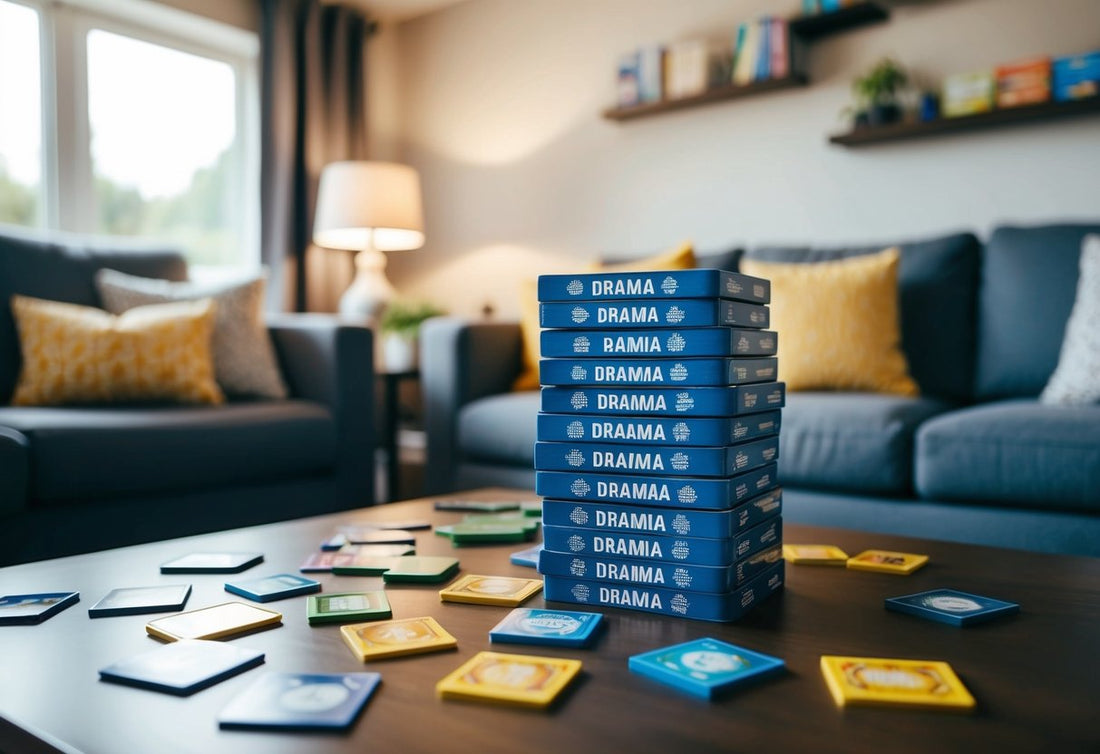
5 Simple Drama Games to Play at Home: Fun Family Activities for Creative Kids
Share
Drama games offer a fantastic way to spark creativity and bring families closer together. We've put together a collection of simple yet engaging activities that can be enjoyed right in your living room.

Whether you're looking for a rainy day distraction or a new family tradition, our list has something for everyone. From classic improv games to imaginative role-playing scenarios, these activities require minimal preparation and can be adapted to suit various ages and group sizes. Get ready to unleash your inner thespian and create lasting memories with your loved ones!
1) Emotional Statues

Emotional Statues is a fun and engaging drama game that we can easily play at home with our kids. It's a great way to help children explore and express different emotions.
To start, we gather everyone in an open space. One person acts as the "director" while the others are the "statues." The director calls out an emotion, and the statues must quickly strike a pose that represents that feeling.
We can make it more challenging by having the statues hold their positions for a set time. This encourages focus and body control. It's also a fantastic opportunity for us to discuss the various ways people might express the same emotion.
As parents, we can join in the fun too! Our participation not only makes the game more enjoyable but also helps strengthen our bond with our children. We might be surprised at how creative and expressive our little ones can be.
This game is perfect for all ages and can be adapted to suit different skill levels. We can use simple emotions for younger kids and more complex ones for older children or adults. It's a wonderful way to spend quality time together while fostering emotional intelligence.
2) Mirrors

Mirrors is a fun and engaging drama game we can play at home with our kids. It's a simple yet effective way to encourage imagination and improve concentration.
To start, we pair up with our children. One person acts as the "mirror" while the other is the "actor." The actor makes slow, deliberate movements, and the mirror copies them as precisely as possible.
We can make this game more exciting by incorporating different scenarios. For example, we might pretend we're getting ready for school or preparing a meal. This adds an element of storytelling to the activity.
As we play, we can switch roles to give everyone a chance to lead and follow. It's a great opportunity for us to bond with our kids while helping them develop their observational skills.
We can also vary the speed of movements to increase the challenge. Slower motions test patience and control, while faster ones add a fun, energetic twist to the game.
3) Role Switch

We love this game for its ability to spark creativity and empathy. Role Switch challenges players to step into someone else's shoes, literally or figuratively. It's perfect for families looking to bond and understand each other better.
To start, we choose characters or professions for each player. These can be family members, fictional characters, or even animals. The more diverse, the better! We set a timer for 5-10 minutes and let the role-playing begin.
During the game, we encourage everyone to fully embrace their new identity. This means adopting different mannerisms, voices, and even imaginary props. It's a great way to practice improvisation skills and think on our feet.
We find that Role Switch often leads to hilarious situations and unexpected insights. It's amazing to see how children interpret adult roles or how parents channel their inner superhero. The game also helps us see situations from new perspectives.
After the timer ends, we take a moment to discuss our experiences. What was challenging about the role? What did we learn? This reflection adds depth to the game and enhances its educational value.
4) Character Hot Seat

Character Hot Seat is a fun and engaging drama game that can easily be played at home. We choose one person to sit in the "hot seat" and take on the role of a specific character.
The character can be from a book, movie, or even a historical figure. Other players then ask questions, and the person in the hot seat must answer as their chosen character would.
This game helps develop improvisation skills and encourages creative thinking. It's a great way for us to explore different personalities and perspectives.
We can make it more challenging by setting a time limit for each round. This adds an element of pressure and excitement to the game.
For younger children, we might want to start with familiar characters from their favorite stories. As they become more comfortable, we can introduce more complex characters.
5) One Word Story
One Word Story is a fantastic game that sparks creativity and encourages quick thinking. We love how it brings families together for a fun, engaging activity that requires no special equipment.
To play, we gather in a circle and take turns adding one word at a time to create a story. The first player starts with a single word, and each subsequent player adds another word to build the narrative.
We find it hilarious how unexpected twists and turns can emerge as each family member contributes their unique ideas. It's amazing to see how a simple premise can evolve into a wild and imaginative tale.
This game is perfect for car rides, waiting rooms, or lazy afternoons at home. We appreciate how it helps improve vocabulary and listening skills while fostering a sense of teamwork and shared creativity.
For an extra challenge, we sometimes set a theme or include specific words that must be used in the story. This adds an element of strategy and makes the game even more engaging for older children and adults.
